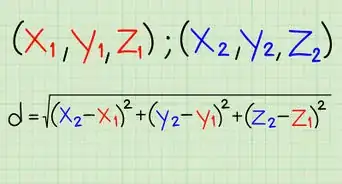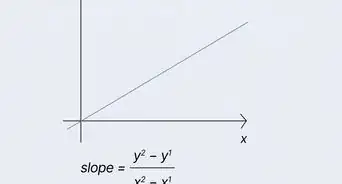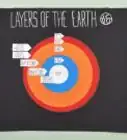This article was co-authored by wikiHow Staff. Our trained team of editors and researchers validate articles for accuracy and comprehensiveness. wikiHow's Content Management Team carefully monitors the work from our editorial staff to ensure that each article is backed by trusted research and meets our high quality standards.
There are 15 references cited in this article, which can be found at the bottom of the page.
This article has been viewed 17,426 times.
Learn more...
Data science (which combines scientific and technological skills to interpret massive quantities of data) is consistently ranked as one of the most desirable career fields of the 21st century.[1] To enter this field, you can either earn a degree in data science at a university or take massive online open courses (MOOCs) for free at home or enter an intensive data science bootcamp. Before you know it, you can be a professional data scientist too!
Steps
Earning a Data Science Degree
-
1Take classes in math and computer science while in high school. Data science requires an extensive background in statistics, algebra, calculus, and computer science. It’s a good idea to start learning these skills as early as possible.[2]
- Make sure that you get at least a basic education in Python, R, and SQL, since they are the basic programming languages you’ll be using for the rest of your career.[3]
- Python is a no-frills programming language that allows data scientists to focus on their research questions rather than code syntax.[4]
- R is a programmable environment that is used to store complex data-analysis in command-line script.[5]
- SQL (Structured Query Language) allows researchers to manipulate and query data in related databases.[6]
-
2Attend a university with reputable programs related to data science. Search online on Google or on college ranking sites like U.S. News for universities with top-rated programs in fields related to data science. There are universities with degrees in data science, but you can also enter the field with a degree in computer science, statistics, mathematics, economics, or operation research.[7]
- You should also consider asking your guidance counselor for advice, contacting departments to which you’re considering applying, and corresponding with data scientists themselves.[8]
- Earning an undergraduate degree in data science or a related field will most likely require 4 years to complete.[9]
- During your time as an undergraduate, you should focus in particular on taking statistics, business, and computer science courses.[10]
Advertisement -
3Go to graduate school if you want to qualify for supervisory positions. Many data scientists enter the field after completing a master’s or Ph.D, particularly those interested in supervisory positions.[11] In the spring of your junior year, ask your college advisor about which data science programs would be the best fit for you and what you can do to get into them.[12]
- Graduate school can be expensive and time consuming, but it does add structure and can help with networking.[13]
-
4Start searching for jobs in data science. After graduation, you can search online for data science positions and attend networking events like data science conferences and seminars. Over the course of your time in undergrad and grad school, your professors and advisors will have helped you to develop a portfolio of the work you’ve completed during your studies. Have that portfolio ready for interviews and meet-and-greets.[14]
- You can use your data science degree in a wide variety of fields like technology, pharmaceuticals, government, retail, and gaming so cast a wide net in your job search.
Taking Massive Online Open Courses from Home
-
1Find reputable MOOC programs in data science. Massive online open courses are university-level courses taught online by experts in the field. Search online for available MOOC programs that host courses in the skills necessary for you to become a data scientist. The large majority will be free, but some may charge fees. Make sure to read reviews of each program to ensure their quality.[15]
-
2Take classes in basic data science skills. The first MOOCs you’ll want to take will be in basic programming languages like Python, R, and SQL. As you progress, you can move on to advanced courses in those programming languages until you have them down pat.[16]
- Once you’ve mastered Python, R, and SQL, you should consider taking courses in other programming languages with more specific uses to round out your skill set.
-
3Sign up for courses in math and machine learning. Once you’ve established a foundation in Python, R, and SQL, you should take some MOOCs in statistics, calculus, algebra, economics, and machine learning (programming that allows computers to “learn” through statistical language).[17]
- Data scientists often have need of public speaking skills and business savvy. Consider taking some MOOCs in those fields as well.
-
4Put together a portfolio of your work. If you choose to take MOOCs rather than attend a traditional university, there may be more pressure on you to prove your skills. Have a thorough portfolio of your work in the field ready to show off what you can do.[18]
- The work in your portfolio should be made up of work from your MOOCs, from any freelance jobs you may have completed, and your personal website if you have one.
- Feature personal, in-depth projects you’ve done in your portfolio, not minor datasets.
- The work you feature in your portfolio should be publicly available. Do your work on sites like Kaggle and Github.
- Accompany your work with an online presence on a blogging platform and social media.
-
5Start your career in data science. Search for a job online and attend networking events. Make sure to bring your portfolio with you to show new people you meet in the field. Keep an eye out for listings in fields like the tech sector, the government, marketing, consulting, and healthcare. Each has a use for someone with a background in data science.
- If you took a MOOC program in data science, it will provide you with documentation certifying your completion of its courses. Include this documentation in your resume.
Participating in a Bootcamp
-
1Learn basic data science skills before bootcamp. Data science bootcamps are intensive, short-term, in-person certification programs, so you’ll want to be as prepared as possible so that you can effectively use your time there. Having at least an intermediate knowledge of programming languages, math, and computer science will help you get a leg up once you’ve started your data science bootcamp.[19]
-
2Read reviews of data science bootcamps online. Search on Google and data science forums for reviews of the data science bootcamps available. You can also consider contacting data scientists in the field to find out their opinions on the best bootcamps out there.[22]
-
3Pick the bootcamp that most closely matches your needs. Data science bootcamps last an average of 10 to 11 weeks, but some of the more prestigious ones can last a full 6 months. The more prestigious bootcamps also cost more. Make sure to find a bootcamp that balances your scheduling and financial needs.[23]
- There may be bootcamps in your area, but there is a good chance you will need to travel to a larger city to attend one. This makes scheduling and finances particularly important.
-
4Attend your bootcamp. During your bootcamp, you’ll have the opportunity to receive direct instruction in data science, produce work for your portfolio, and network with other established and emerging data sciences. You’re going to have to study hard and work harder, but don’t get bogged down in it. Make sure that you’re also using your time to get a sense of the field, who’s in it, and your place in it.
-
5Construct a portfolio. Your bootcamp and any MOOCs you’ve taken will give you some work to start off your portfolio, but you should also feature any freelance work you’ve done and personal, in-depth projects from public sites like Kaggle and Github. Accompany your portfolio with a well-established online presence on a blogging platform and on social media.[24]
- Ask your instructors at your bootcamp for help putting together your portfolio.
-
6Network with other data scientists and apply for jobs. Search online for jobs in fields like technology, healthcare, the government, retail, and gaming. Attend conferences and meet-and-greets to network with other people in the field. Bring your portfolio along to show off your skills.
- Your MOOC courses and bootcamp will most likely provide you with documents certifying your completion of them. Include those documents in your resume.
References
- ↑ https://www.forbes.com/sites/drewhansen/2016/10/21/become-data-scientist/#48b5ccdf87d3
- ↑ https://opensource.com/article/17/9/data-scientist
- ↑ https://opensource.com/article/17/9/data-scientist
- ↑ https://www.infoworld.com/article/3204016/python/what-is-python.html
- ↑ https://www.computerworld.com/article/2497143/business-intelligence/business-intelligence-beginner-s-guide-to-r-introduction.html
- ↑ https://www.infoworld.com/article/3219795/sql/what-is-sql-structured-query-language-explained.html
- ↑ https://www.forbes.com/sites/drewhansen/2016/10/21/become-data-scientist/#9f3101887d33
- ↑ https://blog.prepscholar.com/what-college-should-i-go-to-how-to-choose-a-college
- ↑ https://www.stitchdata.com/blog/5-things-you-should-know-before-getting-a-degree-in-data-science/
- ↑ https://www.stitchdata.com/blog/5-things-you-should-know-before-getting-a-degree-in-data-science/
- ↑ https://www.stitchdata.com/blog/5-things-you-should-know-before-getting-a-degree-in-data-science/
- ↑ https://www.noodle.com/articles/how-to-apply-to-grad-school-in-10-easy-steps
- ↑ https://www.forbes.com/sites/drewhansen/2016/10/21/become-data-scientist/#5dd8143d87d3
- ↑ https://towardsdatascience.com/how-to-get-a-job-as-a-data-scientist-f417078fe13e
- ↑ https://towardsdatascience.com/how-to-choose-effective-moocs-for-machine-learning-and-data-science-8681700ed83f
- ↑ https://towardsdatascience.com/how-to-choose-effective-moocs-for-machine-learning-and-data-science-8681700ed83f
- ↑ https://towardsdatascience.com/how-to-choose-effective-moocs-for-machine-learning-and-data-science-8681700ed83f
- ↑ https://medium.com/one-datum-at-a-time/how-to-construct-a-data-science-portfolio-from-scratch-de0b70e58bc1
- ↑ https://www.springboard.com/blog/4-tips-get-data-science-bootcamp/
- ↑ https://www.springboard.com/blog/4-tips-get-data-science-bootcamp/
- ↑ https://zapier.com/blog/learning-new-skills/
- ↑ https://www.springboard.com/blog/4-tips-get-data-science-bootcamp/
- ↑ https://zapier.com/blog/learning-new-skills/
- ↑ https://medium.com/one-datum-at-a-time/how-to-construct-a-data-science-portfolio-from-scratch-de0b70e58bc1
About This Article
If you want to be a data scientist, you’ll need to take plenty of math and computer science classes in high school, since data science requires extensive statistics, algebra, calculus, and computer skills. As you choose a university or college, look for ones with top-rated programs in math and computer science. Alternatively, search online for reputable online courses in basic programming languages taught by experts in the field. Since many of these classes are free, it’s important to build a strong portfolio of work that shows you have the same amount of experience as someone with a degree. In your portfolio, feature personal, in-depth projects with work that’s publicly available on Kaggle or Github. For more help, including how to become a data scientist through a bootcamp, scroll down.


















-Electric-Shock-Step-9.webp)























































